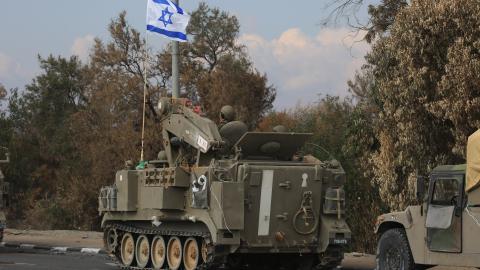Three Things about the Israel-Hamas War is a new series from the Hudson Center for Peace and Security in the Middle East. Every week, Hudson Senior Fellows Michael Doran, Can Kasapoğlu, and Jonathan Schachter will each offer an analysis of one thing—and one thing only—that is of particular importance to understand the Israel-Hamas war. Subscribe here.
Read their analysis below.
1. America is losing.
Three weeks ago, Saudi Arabia and Israel were moving closer to normalizing relations, Turkey and Israel seemed on the cusp of a new era of cooperation, and the Biden administration was bragging that, thanks to its policy of engaging Iran, it had produced a period of unprecedented calm in the Middle East. All of that is gone—possibly for a very long time, certainly for a few years.
America’s setbacks are Iran’s victories. How did Tehran achieve them? The Islamic Republic has three macro-advantages over the United States. First, Iran possesses an abundance of loitering munitions, ballistic missiles, and cruise missiles. By delivering these weapons to a network of allies and proxies in its “Resistance Axis,” Iran has achieved an offense-dominant regime in the Middle East. It has created a balance of power that favors aggressive action.
Second, Tehran—working with Russia, China, Syria, Hezbollah, and Hamas—has created an extremely effective global propaganda network. Its cyber-enabled political warfare capabilities are vastly superior to those of the United States, which has a rudimentary information warfare capacity in comparison.
Third, the American alliance system in the Middle East is in tatters. The Obama and Biden administrations’ Iran outreach has sown distrust between the White House and Israel and Saudi Arabia. Other geopolitical events have strained US relations with Egypt and Turkey.
Ankara, Jerusalem, Cairo, and Riyadh are the four legs of the platform on which the United States stands in the Middle East, and that structure is creaky to say the least. Meanwhile, Iran’s “Resistance Axis” is more unified than ever before.
— Michael Doran
2. We do not know where the battlefield is.
Is the battlefield in Gaza—or is it on the Israel-Lebanon border, or in Iraq, Syria, Yemen, or even Iran? There is no clear answer to this critical question because the battlefield’s basic contours are blurry. In an interview last weekend, Nir Barkat, Israel’s minister of economy, warned that Iran’s ayatollahs would be “wiped off the face of the earth” if Lebanese Hezbollah, an Iranian proxy, attacked Israel. In the meantime, the Iranian Revolutionary Guard Corps’s proxy network, which extends from the Red Sea to the Levant, is creating a series of flashpoints across the region.
In Yemen, the Houthi militia launched drones and missiles, presumably at Israel, but the US Navy destroyer USS Carney intercepted the salvo. Meanwhile, Islamic Jihad gunmen are using Lebanese Hezbollah–controlled territory to attack Israel as Hezbollah intensifies hostilities, and Iran is targeting America’s presence in Syria and Iraq.
Two distinct strategies are clashing. For Israel, a decisive victory hinges on its ability to keep the battlefield narrow and well-defined. Iran, in contrast, aims to widen and muddle the conflict. For now, Iran can escalate the conflict horizontally in the region but has not yet done so. This dynamic creates an uncertainty that forces Israel to expend resources in multiple domains as long as a multifront war remains a possibility.
— Can Kasapoğlu
3. Up is down, wrong is right.
For decades, the Israeli-Palestinian conflict has been reminiscent of the “Bizarro World,” in which almost everything appears backward. Those dwelling in this alternate reality blame Israel, which has called for peace from its earliest days, for the conflict’s continuation. At the same time, they claim that Palestinian leaders are partners for peace—even though these leaders and their predecessors have repeatedly rejected peace proposals (including several that would have created an independent Palestinian state). Though Israel is a democracy and the Palestinian Authority and Hamas-ruled Gaza are dictatorships, world leaders often dismiss Israeli public sentiment while displaying remarkable sensitivity to attitudes among the constituents of a Palestinian president who was elected to a four-year term some 18 years ago.
The current war has intensified and expanded these distortions in telling ways. The false accusations that Hamas and Islamic Jihad, as well as their supporters and apologists, have leveled against the Jewish state reliably reveal their own savagery. Their misdirection includes deceitfully claiming Israel is targeting civilians, engaging in genocide, and fabricating the October 7 attack. (Yes, 10/7 denial has begun.) Yet it is the Palestinian terrorist groups that are deliberately targeting women, children, the elderly, and other noncombatants. The terrorists’ ideology is explicitly genocidal. And, as they have done in every previous round of fighting with Israel, they and their fellow travelers fabricate photos of alleged atrocities. The list of lies goes on.
— Jonathan Schachter





















